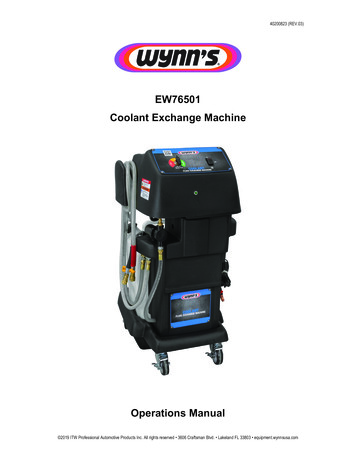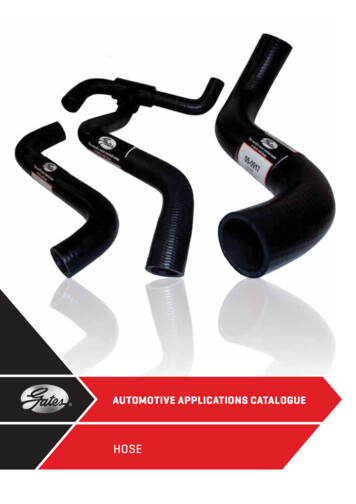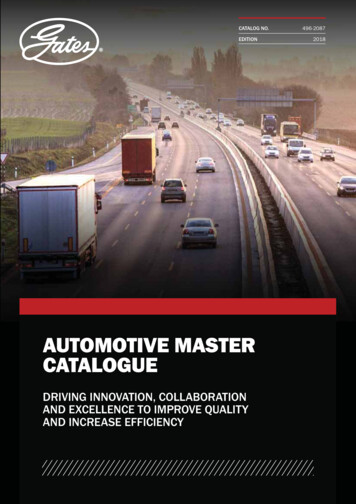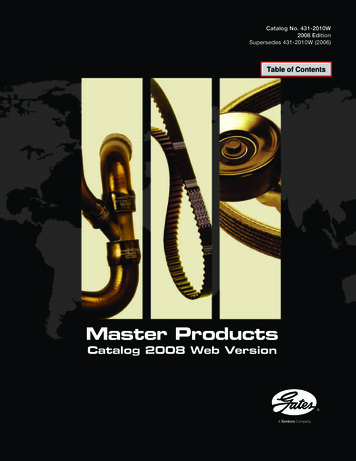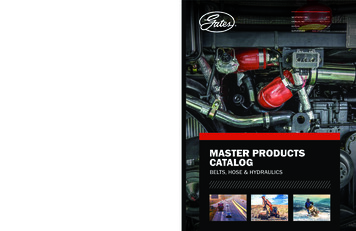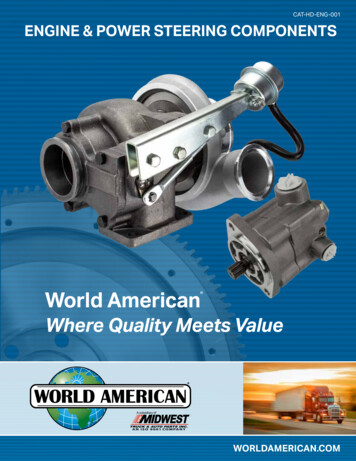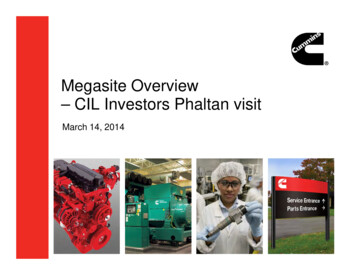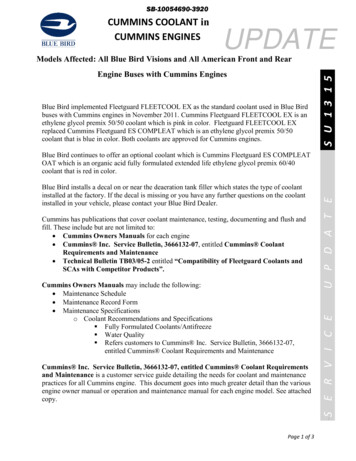
Transcription
SB-10054690-3920UPDATEModels Affected: All Blue Bird Visions and All American Front and RearEngine Buses with Cummins EnginesBlue Bird implemented Fleetguard FLEETCOOL EX as the standard coolant used in Blue Birdbuses with Cummins engines in November 2011. Cummins Fleetguard FLEETCOOL EX is anethylene glycol premix 50/50 coolant which is pink in color. Fleetguard FLEETCOOL EXreplaced Cummins Fleetguard ES COMPLEAT which is an ethylene glycol premix 50/50coolant that is blue in color. Both coolants are approved for Cummins engines.-S U 1 3 1 5 ---CUMMINS COOLANT inCUMMINS ENGINESCummins has publications that cover coolant maintenance, testing, documenting and flush andfill. These include but are not limited to: Cummins Owners Manuals for each engine Cummins Inc. Service Bulletin, 3666132-07, entitled Cummins CoolantRequirements and Maintenance Technical Bulletin TB03/05-2 entitled “Compatibility of Fleetguard Coolants andSCAs with Competitor Products”.Cummins Owners Manuals may include the following: Maintenance Schedule Maintenance Record Form Maintenance Specificationso Coolant Recommendations and Specifications Fully Formulated Coolants/Antifreeze Water Quality Refers customers to Cummins Inc. Service Bulletin, 3666132-07,entitled Cummins Coolant Requirements and MaintenanceCummins Inc. Service Bulletin, 3666132-07, entitled Cummins Coolant Requirementsand Maintenance is a customer service guide detailing the needs for coolant and maintenancepractices for all Cummins engine. This document goes into much greater detail than the variousengine owner manual or operation and maintenance manual for each engine model. See attachedcopy.Page 1 of 3-S E R V I C EBlue Bird installs a decal on or near the deaeration tank filler which states the type of coolantinstalled at the factory. If the decal is missing or you have any further questions on the coolantinstalled in your vehicle, please contact your Blue Bird Dealer.U P D A T EBlue Bird continues to offer an optional coolant which is Cummins Fleetguard ES COMPLEATOAT which is an organic acid fully formulated extended life ethylene glycol premix 60/40coolant that is red in color.
275 Gal. Tote (1040 L)55 Gal. Drum (208 L)6/ 1 Gal. Bottle (3.78 L)6/ 1 Qt. Bottle (0.94 L)275 Gal. Tote (1040 L)55 Gal. Drum (208 L)6/ 1 Gal. Bottle (3.78 L)6/ 1 Qt. Bottle (0.94 L)275 Gal. Tote (1040 L)55 Gal. Drum (208 L)6/ 1 Gal. Bottle (3.78 L)6/ 1 Qt. Bottle (0.94 L)275 Gal. Tote (1040 L)55 Gal. Drum (208 L)6/ 1 Gal. Bottle (3.78 L)6/ 1 Qt. Bottle (0.94 L)FLEETCOOL EXEG ConcentrateCC2740CC2741CC2742FLEETCOOL EX EGPremix 50/50CC2744CC2745CC2746EX ExtenderES Compleat EGConcentrateCC2823CC2821CC2820ES Compleat EGPremix 50 50CC2834CC2826CC2825ES ExtenderES Compleat OATEG ConcentrateCC36071CC36072CC36073ES Compleat OAT EGPremix 50 50CC36075CC36076CC36077OAT ExtenderES Compleat OATEG ConcentrateCC36071CC36072CC36073ES Compleat OAT EGPremix 60/40CC36079CC36078OAT ExtenderCC2765CC2840CC2779CC2779Page 2 of 3- ES Compleat EG Premix or Concentrate with DCA4 (color, blue) Fleetcool EX EG Premix and Concentrate with modified DCA4 (color, pink) ES Compleat OAT (does not contain DCA4 or DCA2) (color, red) As a quick reference the tables below shows the Fleetcool EX EG (pink), ES Compleat EG(blue), and ES Compleat OAT EG (red) Fleetguard Part Numbers:U P D A T EThe Fleetguard coolants that Cummins Inc. recommends are:-S U 1 3 1 5 -UPDATECummins has published Technical Bulletin TB03/05-2 entitled “Compatibility of FleetguardENGINESCoolants and SCAs withCUMMINScompetitor Products“(attached). Although it is acceptable to mixany of the Fleetguard coolants listed below in a Cummins engine in a Blue Bird chassis, Blue Birdrecommends that mixing be avoided if at all possible.-S E R V I C ECUMMINS COOLANT inCUMMINS ENGINES
UPDATEQUESTION AND ANSWERS1. Question: Is the Fleetcool EX EG a recycled coolant?Answer: NO, it is a virgin ethylene glycol coolant. .2. Question: If a cooling system is equipped with a Fleetguard coolant filter, when shouldthe filter be changed?-S U 1 3 1 5 -CUMMINS COOLANT inCUMMINS ENGINES-Answer: Follow Cummins recommendations in Cummins Owner’s Manual andCummins Coolant Requirements and Maintenance Service Bulletin 3666132.4. Question: When should I replace the coolant?Answer: See the engine Cummins Owner’s Manual which was supplied with your bus.Additional information is also available in the Cummins Coolant Requirements andMaintenance Service Bulletin 3666132.5. Question: How and when should the cooling system be flushed?Answer: Follow Cummins recommendations in Cummins Owner’s Manual which wassupplied with your bus and Cummins Coolant Requirements and Maintenance ServiceBulletin 3666132.6. Question: Who should a customer contact with questions on Cummins coolants inCummins engines?Answer: Email www.fleetguard.com or call the Cummins Filtration (Fleetguard)Technical Assistance hotline at 800-223-4583 or contact your Blue Bird Dealer.Page 3 of 3-S E R V I C EAnswer: Follow Cummins recommendations in Cummins Owner’s Manual andCummins Coolant Requirement s and Maintenance Service Bulletin 3666132.Recommend using Cummins lab for testing. Always specify the correct component type(Fleetcool EX EG 50/50 Premix) and brand (Cummins Coolant).U P D A T E3. Question: How and when should I test my engine coolant?
Service Bulletin Number3666132-07Date29-JUL-2013Service BulletinCummins Coolant Requirements andMaintenanceThis Service Bulletin supersedes prior Service Bulletins concerning Cummins Inc. coolantrequirements and maintenance; replace those Service Bulletins with this one.This Service Bulletin outlines the proper application and maintenance of coolant for allCummins engines, including gaseous fueled engines. It also updates and simplifiesCummins Inc. recommendations and guidelines for the end user.Summary of RecommendationsCummins Inc. cooling system general recommendations are listed below. Theserecommendations apply to both Standard Service Intervals and Extended ServiceIntervals. See Section 2 or 3 for complete instructions. Fill up and top off cooling systems with a fully formulated antifreeze/coolant meetingCummins Engineering Standard 14603.Replace the coolant filter(s) at every recommended coolant filter change interval.Add liquid supplemental coolant additive (SCA) at each filter change as necessaryor add liquid Extender per the coolant supplier's recommendations.Test coolant at least twice per year for liner-pitting protection (nitrite and molybdatelevels).Test coolant for replacement limits every 240,000 km [150,000 mi ], 4000 hours, oronce per year, whichever occurs first.Replace coolant only if replacement limits have been exceeded.Definition of Terms
TermDefinitionExtenderExtended Service AdditiveSCASupplement Coolant Additive (Standard service interval additive)CoolantAs used in this bulletin, coolant refers to the liquid mixture in the engine orvehicle cooling system that functions to maintain an engine temperature inthe designed range. In general, the coolant is made up of water, glycol andadditives. Also referred to as “Prediluted” or “Premix”.AntifreezeThe glycol or glycerin and additive portion of the coolant whose mainfunction is to control corrosion and the freezing/boiling point of the coolant.Also referred to as “Concentrate”.FullyFormulatedAntifreeze or coolant that contains the correct amount of additives to beused in a heavy duty engine. Fully formulated antifreeze/coolant meetsASTM D6210.PartiallyFormulatedAntifreeze or coolant that requires a “precharge” of supplemental coolantadditive to protect against liner pitting and hot surface scaling. Partiallyformulated antifreeze/coolant does not meet American Society for Testingand Materials (ASTM) D6210.TreatedWaterCoolantWater containing all additives necessary for use as a coolant in heavy dutyengines. Treated water coolant does not contain glycol or glycerin.Unit0.3 units per liter [1 unit per gal] is equal to 1000 ppm of Nitrite (as NO 2).Section 1 - IntroductionCummins Inc. coolant recommendations have evolved over time to reflect changes indiesel engine and coolant technology, environmental regulations, and customer needs.Since 1995, Cummins Inc. has recommended the use of only fully formulated coolantsmeeting ASTM D6210/The Maintenance Council RP 329 (ethylene glycol) and TheMaintenance Council RP 330 (propylene glycol) specifications.However, Cummins Inc. has recently discovered significant weaknesses in some coolantsmeeting these ASTM specifications. Therefore, a new Cummins Engineering Standard,Cummins Engineering Standard 14603, has been developed to make sure coolant used inCummins engines will meet the requirements of all engine components. See Attachment2 for more information on Cummins Engineering Standard 14603.Cummins Inc. guidelines prior to 1995 permitted the use of fully formulatedantifreezes/coolants meeting ASTM D6210, but primarily addressed the use of partiallyformulated products meeting ASTM D4985 or GM 6038M, which were referred to as"heavy duty" based on the low-silicate content. These partially formulated coolantscontained buffering compounds and corrosion inhibitors, but did not provide liner pittingand scale protection. To provide total heavy-duty cooling system protection, a mixing
process was required to add SCA. This mixing process provided opportunity for humanerror, which often resulted in liner or block pitting from under-concentration during initial fillor SCA dilution during top-off of the cooling system. Because of these issues, the use ofpartially formulated antifreezes is unacceptable.Fully formulated antifreezes are ideally suited for topping off cooling systems, but do noteliminate the need for additive replenishment. Routine additive replenishment has alwaysbeen required to offset normal additive depletion processes.During normal additive replenishment, it is possible to achieve an additive concentrationthat is higher than desired. This is because Cummins Inc. recommended replenishmentrates have been aimed to compensate for coolant loss. If no coolant loss is experienced,gradual Extender/SCA concentration increase is possible. Overconcentration can beavoided by monitoring with a test kit.However, the use of test kits to maintain a concentration near the minimum side of theacceptable range has never been acceptable nor recommended. This practice isresponsible for many pitting failures and should not be followed.Coolant Performance CharacteristicsTable 1 below lists the various types of coolants and the performance characteristics ofeach. As mentioned earlier in this section, only fully formulated antifreeze/coolant meetingCummins Engineering Standard 14603 is recommended for use in Cummins engines.Table 1 - Coolant Type versus PerformanceCharacteristicsLight DutyLow Silicate andSCAFully on ProtectionYesYesYesFoam ControlYesYesYesSilicate DepositControlNoYesYes–NoNoASTM SpecificationSCA PrechargeRequired
Light DutySilicate GelationPrimary causeLow Silicate andSCACan occur with SCAoverdoseTotal DissolvedSolids Buildup inCoolant–Can exceed 5 percentExtended ServiceInterval CapableNoNoSystem Top-OffSCA added withantifreeze/coolantFully FormulatedSCA added withantifreeze/coolantNoRemains below 3percentYesAntifreeze/CoolantonlyTopping Off and Dilution of Cooling SystemsCoolant loss can lead to dilution of corrosion and liner-pitting protection additives due toincorrect top-off practices. This is the root cause of most cases of liner-pitting. The top-offprocess is simplified by the use of fully formulated antifreezes and coolants because SCAaddition is not required when topping off the system. Even small leaks at the hose clamps,radiator cores, cylinder head gaskets, and water pumps result in significant coolant lossover time. Dilution of critical additives is avoided, regardless of the amount of coolant loss,by using fully formulated products for system top-off.Standard Service Interval Coolant versus ExtendedService Interval CoolantBoth types of coolant follow the same general test schedule: Test at least twice a year for additive and glycol levelsTest coolant at 240,000 km [150,000 mi], 4000 hours, or once per year, whicheveroccurs first, to determine if the coolant must be replaced.The advantage to using an extended service interval coolant is that typically the coolantonly needs additive replenishment and filter change once per year, compared to thestandard service interval where the additive and filter is replenished at each oil changeinterval.Section 2 of this bulletin details the standard service interval and Section 3 details theextended service interval.Additional InformationIf you have any questions about information in this bulletin or would like more information,please contact 1-800-DIESELS.
Section 2 - Standard Service IntervalThis section outlines the recommended maintenance practices for cooling systems whenusing a standard service interval.WARNINGA small amount of coolant can leak when servicing the coolant filter with the shutoff valvein the OFF position. To reduce the possibility of personal injury, avoid contact with hotcoolant.WARNINGCoolant is toxic. Keep away from children and pets. If not reused, dispose of inaccordance with local environmental regulations.For an engine using standard service interval coolant, the additive and glycol levels mustbe tested once every 6 months.The following steps are required to comply with Cummins Inc. recommendations for initialfilling and maintenance of cooling systems. Fill the cooling system with premixed fully formulated coolant or with a 50/50mixture of high-quality water (see Section 9 - Water Quality Requirements) and fullyformulated concentrated antifreeze. The fully formulated coolant/antifreeze, eitherethylene glycol or propylene glycol, must meet Cummins Engineering Standard14603. Cummins Inc. recommends using Fleetguard coolants containing DCA4chemistry; however, Fleetguard coolants containing DCA2 chemistry areacceptable.Top off the cooling system as needed using only fully formulated antifreeze/coolantmeeting Cummins Engineering Standard 14603.Change the coolant filter(s) at every oil change. The coolant filter must meetCummins Engineering Standard 14315.Replenish depleted coolant additives at every oil change or as needed by replacingthe coolant filter(s) with the correct filter(s) or liquid SCA. Very large coolingsystems can require additional liquid SCA if standard coolant filters do not providesufficient SCA replenishment. Consult Cummins Filtration Technical Assistancefor detailed Fleetguard product information and assistance for filter sizes and partnumbers at 800-223-4583 or www.Cumminsfiltration.com.Test the coolant twice a year for freeze protection and additive levels.Refractometer measurements provide the most accurate freeze protection
measurements. Test strips, although less accurate than a refractometer, will alsoprovide an indication of freeze protection and additive levels. See Section 6 Coolant Testing for further information and test strip part numbers.Test the coolant every 240,000 km [150,000 mi], 4000 hours or once per year,whichever occurs first, to determine if it must be replaced. See Section 6 - CoolantTesting for further information and test strip part numbers.Replace the coolant only if the replacement limits are exceeded.SCA LevelsTest the SCA level a minimum of twice a year. If the SCA concentration level is between 0.3 and 1.3 units/liter [1.2 and 5.0 unitsper gal], either install a chemical filter containing the appropriate dosage of SCA oradd the equivalent liquid SCA dosage and install a chemical free filter. For largecooling systems, it can be necessary to replenish SCA with both a chemical filterand liquid SCA.If the SCA concentration level is less than 0.3 units/liter [1.2 units per gal], add 0.15liters [5 ounces] of Fleetguard DCA4 or Fleetcool liquid per 3.8 liters [1 gal] ofcooling system capacity and install a chemical filter.If the SCA concentration level is greater than 1.3 units/liter [5.0 units per gal], installa chemical free filter. Do not install a chemical coolant filter or add liquidExtender/SCA. Test the SCA level at each successive oil change. When SCA unitsdrop below 1.3 units per liter [5.0 units per gal], resume installing chemical filters orusing the equivalent liquid SCA dosage and installing chemical free filters.Consult Cummins Filtration Technical Assistance for detailed Fleetguard productinformation and assistance at 800-223-4583 or www.Cumminsfiltration.com.Section 3 - Extended Service IntervalThis section covers the requirements for coolant products that provide extended servicemaintenance intervals.Extended service interval coolant is defined as a coolant capable of a minimum generalroutine service interval of 240,000 km [150,000 mi], 4000 hours, or 1 year, whicheveroccurs first. It must be noted that organic acid technology (OAT) coolants are generallycapable of extended service intervals ranging from 500,000 km to 1,000,000 km [300,000mi to 600,000 mi] or 6000 hours to 7000 hours. Follow maintenance guidelinesrecommended by the coolant manufacturer.Successful usage of extended service interval products will be possible only if asystematic approach to coolant maintenance is followed by the user. This means using theextended service interval system of coolant products for all coolant maintenance at thefleet shop as well as on the road. Use of the proper coolant is vital for successful extendedservice interval maintenance. If control of top-off can not be accomplished, do notconsider extended service and use the standard service interval as described in Section 2.Coolant must meet the requirements stated in this section.
It is preferred and recommended for all Cummins engines to top off only with fullyformulated coolants which meet Cummins Engineering Standard 14603. See Attachment 2for more information on Cummins Engineering Standard 14603. However, MidRangeproducts, including any Cummins engine displacing less than 10 liters [610 C.I.D.], maytop off with fully formulated coolants meeting a minimum requirement of ASTM D6210.Cummins Inc. recommends Fleetguard Antifreeze Coolants including ES Compleatcontaining DCA4 Plus, Fleetcool EX containing DCA2 Plus, and ES Compleat organic acidtechnology (OAT), which meet the requirements of Cummins Engineering Standard 14603.Cummins Engines That are Using Chevron Texaco or Shell Rotella Extended Life Coolant (TELC) PlusSilicatesOAT coolants, such as Chevron Texaco , Shell Rotella or their private labelcounterparts, which do not meet the elastomer compatibility section of CumminsEngineering Standard (CES) 14603, are acceptable for extended service interval use inHeavy-Duty and High Horsepower engines if the initial coolant fill requirements were metby the vehicles' original equipment manufacturer (OEM), (including the addition ofsilicates). See Cummins AEB 90.47 which can be accessed onhttp://www.gce.cummins.com. All midrange engines are TELC compatible without theaddition of silicates.Heavy-Duty and High Horsepower engines requiring overhauls or repairs involving thereplacement of the following components that are using OAT coolants not meeting CES14603, must discard the original coolant and replace with new. Rocker lever housingOil cooler housingCylinder head gasketThermostat housing gasketOil cooler cover gasketV cavity gasketIf the replacement coolant is Chevron Texaco , Shell Rotella or their private labelcounterparts, which do not meet the elastomer compatibility section of CES 14603, thecoolant must be treated by adding 0.24 liter [8 oz] of liquid silicate fluid for every 45 liters[12 gal] of total coolant system volume. It is critical to not over treat the coolant withsilicate fluid. If over-treatment is suspected, drain the cooling system and discard the filter.Clean the cooling system immediately. Symptoms of silicate over-treatment can bethickened coolant in the lower radiator tank, water pump seal leakage soon after silicateaddition, reduced heater output and/or elevated engine temperatures. Use Fleetguard Restore Cooling System Cleaner at the rate of 3.8 liters [1 gal] per 38 to 45 liters [10 to12 gal] of water. Do not use Restore with normal engine coolant.To obtain order forms or ask questions relative to ordering the silicate fluid:
Phone: 800-346-9041Fax: 800-876-5317Mail To: Silicate Fluid Order ProgramP.O. Box 27388Houston, TX 77227-7388Extended Service Maintenance Fill the cooling system with premixed fully formulated coolant or with a 50/50mixture of high-quality water (see Section 9 - Water Quality Requirements) and fullyformulated concentrated antifreeze. The fully formulated coolant or antifreeze,either ethylene glycol or propylene glycol, must meet Cummins EngineeringStandard 14603. Cummins Inc. recommends using Fleetguard ES Compleat.Some extended service interval systems do not require the initial use of anExtender additive in liquid form or from a slow-release filter. In these systems, theantifreeze/coolant must provide cavitation-corrosion (liner-pitting) protectionthrough the use of the liner-pitting protection additives in the concentrations listed inTable 2. Extender/Extended Service Additive is then added at each extendedservice interval.Table 2 - Liner Pitting Protection Additive LevelsRequired at Initial System FillNOTE: Some OAT coolants do not need nitrite and or molybdate for liner pitting.AdditivePremixedAntifreeze/Type of Coolant(SeeCoolant (ppm)AdditiveNote 1)Minimum Nitrite (measured as NO2)Minimum Levels of Nitrite (measured as NO2) andMolybdate (measured as MoO4)2000 ppm1300 ppm (See Note2)DCA2DCA4NOTE: 1: Concentrated antifreeze/coolant levels are double the premixed levels.NOTE: 2: A combination of nitrite (NO2) and molybdate (MoO4) can not contain lessthan 500 ppm of either additiveNOTE: 3: Some OAT coolants use high levels of organic acids for liner pittingprotection and do not use nitrite and or molybdate.
Top off the cooling system as needed using only fully formulated antifreeze/coolantmeeting Cummins Engineering Standard 14603.The coolant must be tested twice per year for freeze protection and additive levels.A Refractometer provides the most accurate freeze protection measurements. Teststrips, although less accurate than a refractometer, will also provide an indication offreeze protection and additive levels. See Section 6 - Coolant Testing for furtherinformation and test strip part numbers.After 240,000 km [150,000 mi], 4000 hours, or 1 year, whichever occurs first, do thefollowing:Change the coolant filter(s). The coolant filter must meet Cummins EngineeringStandard 14315.Replenish depleted coolant additives either by using slow-release ES chemicalfilter or adding ES Extender liquid. Larger cooling systems may require the use ofa chemical filter in conjunction with liquid additive. See the remainder of this sectionfor filter and liquid part numbers.Test the coolant to determine if it must be replaced. See Section 6- Coolant Testingfor further information and test strip part numbers.Replace the coolant only if the replacement limits are exceeded.Extender/Extended Service Additive LevelsTest the SCA level a minimum of twice a year. Target 0.6 units/liter [2.5 units/gal] in coolant solutions of 40 to 60 percent antifreezeconcentrations.If the SCA concentration level is between 0.3 and 1.3 units/liter [1.2 and 5.0 unitsper gal], either install a chemical filter containing the appropriate dosage ofExtended Service Additive or add the equivalent liquid Extended Service Additivedosage and install a chemical free filter. For large cooling systems, it can benecessary to replenish SCA with both an Extended Service Additive chemical filterand liquid Extended Service Additive.If the SCA concentration level is less than 0.3 units/liter [1.2 units per gal], add 0.15liters [5 ounces] of Fleetguard Extender liquid Extended Service Additive pergallon of cooling system capacity and install a chemical filter.If the SCA concentration level is greater than 1.3 units/liter [5.0 units per gal], installa chemical free filter. Do not install a chemical coolant filter or add liquidExtender/Extended Service Additive. Test the SCA level at each successive oilchange. When SCA units drop below 1.3 units per liter [5.0 units per gal], resumeinstalling chemical filters or using the equivalent liquid Extended Service Additivedosage and installing chemical free filters.Consult Cummins Filtration Technical Assistance for detailed Fleetguard productinformation and assistance at 800-223-4583 or www.Cumminsfiltration.com.Some OAT coolants use high levels of organic acids for liner pitting protection anddo not use nitrite and or molybdate. Therefore, these coolants do not have SCAnumbers.Extender Requirements
CAUTIONExtenders used in extended service interval systems are not fully formulated and must notbe used in treated water coolants. Their usage can result in engine damage. See Section8.The Extender replaces the additives in the coolant that are lost due to depletion. It can beadded as a liquid directly to the coolant or as a solid contained in a coolant filter.Cummins Inc. recommends using a Fleetguard ES slow release filter or ES Extenderliquid.Performance RequirementsThe Extender must contain sufficient liner-pitting additives to increase the levels of nitriteor nitrite plus molybdate in the engine coolant by the following amounts: At least 800 ppm (0.8 units per gallon) of nitrite (NO2)Or a combined total of at least 520 ppm (0.8 units per gallon) of nitrite (NO 2) andmolybdate (MoO4).A combination of nitrite and molybdate can not contain less than 200 ppm of eitheradditive.Storage StabilityLiquid Extenders typically have a shelf life of at least 2 years from the time of manufacturewhen stored at temperatures ranging from -7 to 55 C [19 to 131 F].Solid material, liquid turbidity, or layering at the top of the liquid is allowed if it will dissolveand disperse by stirring the solution and warming it to a temperature between 2 to 67 C[36 to 153 F].Solid, slurry, and paste forms of Extender must dissolve completely in hot engine coolant.They must be formulated and packaged to prevent chemical or physical change duringstorage temperatures ranging from -7 to 55 C [19 to 131 F] regardless of humidity. Consult Cummins Filtration Technical Assistance for detailed Fleetguard productinformation and assistance at 800-223-4583 or www.cumminsfiltration.com.Section 4 - Unacceptable Maintenance Practices forCooling Systems
WARNINGAll diesel engines with wet liners are subject to liner pitting if the cooling system is notcorrectly maintained. Underconcentration (below 0.3 units per liter [1.2 units per gal] ofExtended Service Additive/SCA results in liner cavitation and possible engine failure.Overconcentration (above 1.3 units per liter [5.0 units per gal] of additives) or the use ofhigh-silicate antifreeze can result in silicate gelation or water pump seal leakage.NOTE: Some OAT coolants use high levels of organic acids for liner pittingprotection and do not use nitrite and or molybdate. Therefore, these coolants do nothave SCA numbers.Unacceptable Practices - The following practices are considered unacceptable and maylead to engine failure. Use of high-silicate antifreeze.Underconcentration or overconcentration of Extended Service Additive/SCAs.Use of antifreezes/coolants that are not fully formulated for extended serviceintervals (for instance, GM 6038M or ASTM D4985 antifreeze).Use of soluble oils in the cooling system.Use of poor-quality water. See Section 9 for water quality requirements.Use of antifreeze, Extended Service Additive/SCA or coolant filter(s) that do notmeet the specifications indicated in this Service Bulletin.Use of Treated Water coolant with EGR engines.Use of coolants with less than 40 percent antifreeze for EGR engines.Use of coolants with less than 25 percent antifreeze for marine engines.Section 5 - Recommended Maintenance Practices forCooling Systems of A, B, and F Series EnginesThe A and B Series engines normally do not require Extender/SCA because they do notnormally experience cylinder bore/liner cavitation corrosion. Also, the A and B Seriesengines do not have an integral coolant filter.Coolant maintenance requirements for the Cummins B series engines depend on theapplication.Light duty applications can use coolant meeting ASTM D3306 and follow the maintenanceschedule in the appropriate Owners manual. However, if ASTM D3306 antifreeze is used,it must additionally meet the elastomer capability section of Cummins EngineeringStandard 14603.
Use of fully formulated antifreeze/coolant in this engine is acceptable but not required. Iffully formulated antifreeze/coolant is used, it must meet a minimum requirement of ASTMD6210.The F-Series engines must use coolant meeting ASTM D3306, except North AmericaIndustrial F-Series which may also use coolant meeting ASTM D6210. The F-Series mustfollow the maintenance schedule in the appropriate Owners or Operation and MaintenanceManual.Section 6 - Coolant TestingCoolant testing is required for two reasons:1. To determine the additive concentration and glycol level of the coolant. This willmake sure that adequate liner pitting protection and freeze point protection areachieved.2. To determine if the coolant must be replaced due to contamination.Coolant testing for additive and glycol levels must be performed at least twice a year. Thecoolant must also be tested for replacement limits every 240,000 km [150,000 mi], 4000hours, or once a year, whichever occurs first.Additive and glycol testing is also recommended when the following occur: Coolant loss between test intervals exc
UPDATE -S E R V I C E U P D A T E --S U 1 3 1 5-Page 2 of 3 CUMMINS COOLANT in CUMMINS ENGINES CUMMINS ENGINES Cummins has published Technical Bulletin TB03/05-2 entitled "Compatibility of Fleetguard
